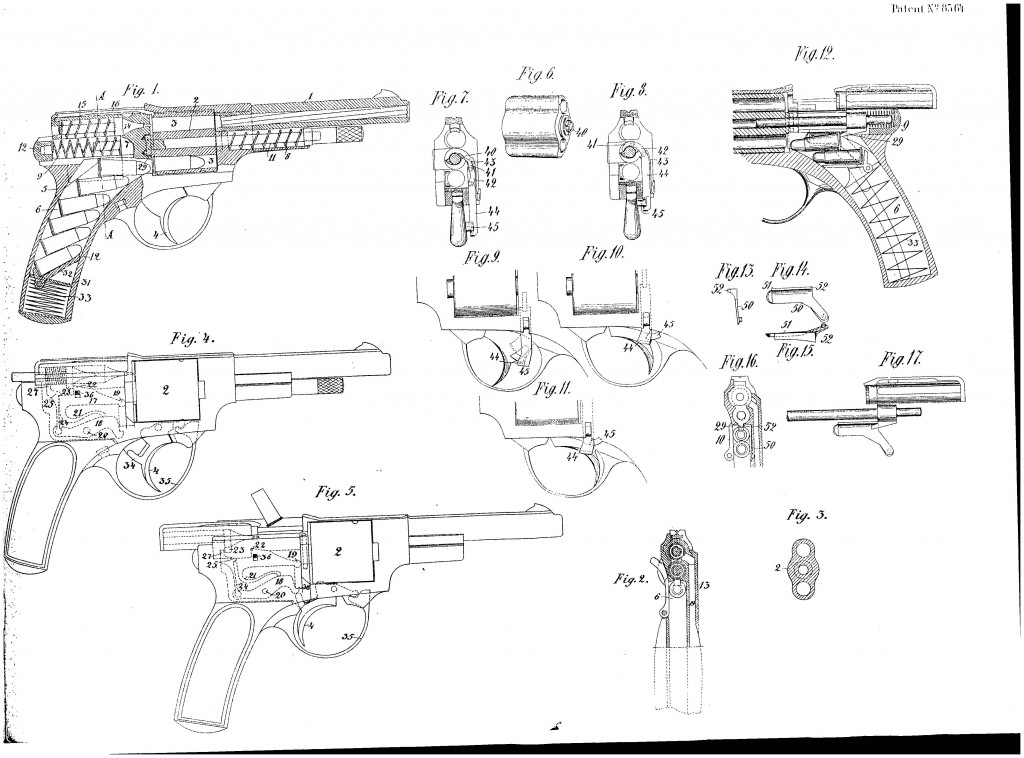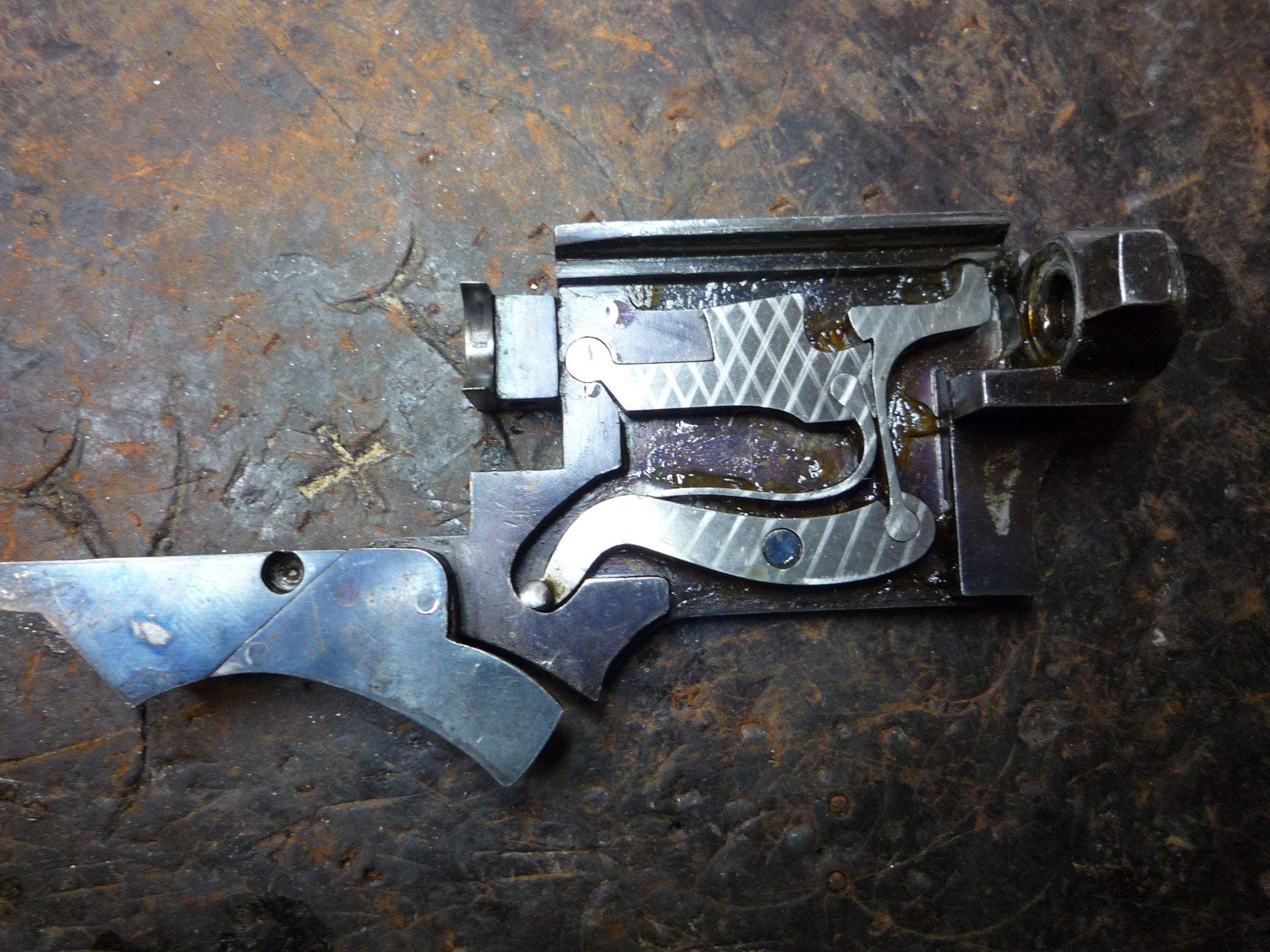A couple pieces of Sunday miscellanea…
First, thanks to Keith we have a copy of the Norwegian patent for the Landstad automatic revolver. He was able to coax it out of the Norwegian patent office, despite it being much too old to be in their online archive. Thanks, Keith! It’s a short patent and we don’t read Norwegian, but the additional drawings alone are pretty cool:

We also dug up a copy of a patent Landstad filed in the UK, to protect his ideas there (it was common for inventors to patent their idea in multiple countries). It’s very helpful to be able to read the text, although the Norwegian version has more drawings.
Secondly, we got an email from David, who is trying to identify a couple rifles. They are on display at the Belgian Army museum in Brussels, but unlabeled, and apparently the museum staff on hand weren’t sure what they were. I can’t identify them either, but I figure someone reading this probably can. Any ideas? They’re in a rack with a bunch of old Mannlicher straight-pull rifles, but those may or may not be related to these two.




Rifles : M 1888 Pieper war rifle
http://www.littlegun.be/arme%20belge/artisans%20identifies%20p/a%20pieper%20h%20fusil%201888%20gb.htm
Thanks! That’s definitely it.
Magazine revolvers,
wow never thought thats there is such devices was exist…
Rounds from magazine feeds into cylinder…
The Dardick ‘tround’ firing pistol was sort of a magazine loading revolver as well. It was developed in the 1950’s and saw limited U.S. production in the 1960’s.
Here is a link to the Dardick 1500 pistol/carbine in the NRA’s National Firearms Museum:
http://www.nramuseum.org/the-museum/the-galleries/the-new-prosperity/case-44-the-mother-of-invention-cartridge-technology/dardick-series-1500-pistol.aspx
I always thought this pistol was an accidental shooting waiting to happen.
Thanks Ian, thanks Keith. This is most remarkable
gun site of net making readers thought wıthout time
waste to create innovations as offering what had been
made in the past. Reaching patents of different
countries is not a task that individuals can carry on.
As understood from the drawings, Lanstad revolver
used a chain tied hand to rotate twin chambers for
180 degrees, and trigger had a definite hesitation
point at its rearward travel arresting itself on
single action mode which could be overriden through
continueing backward exertion.
Hi, Great Stuff.
How is the case extracted from the 2 round cylinder ?
There’s a prominant extractor on the top of the breech bolt (look at fig 17 on the Norwegian patent) it looks almost like a miniature Mauser 98 or more likely a miniature copy of a Krag & Jorgensen extractor.
The bolt is operated by blowback.
blowback actions will generally extract without the help of an extractor, the extractor is there to remove un fired or mis fired rounds, and to control the point around which the case pivots when it hits the ejector – some blowback rifles (Gevarm, Voere and clones) were even made without any extractor, and they work well.
Don´t forget that “Le Francais” pistol: no extractor and pivoting barrel to do it manually
With exception of “Long Recoil” types, most of auto loading firearms can
extract the empty cases from the chamber by push of remaining gas pressure
within the barrel after each shot.
But, irregulaties in the chamber occured either fouling or rust, or simply
during manufacturing, can cause case stoppages which occured by their small
mass related momentum loosing their motional capability against to the
powerfull friction, as heavier bolt continueing the rearward travel and in
that case, an extractor draw should be necessary to carry the empty case
together with breechbolt of bigger mass and gained momentum.
Lugers having longer barrel recoiling distances than usual short recoil types,
also extract empty case by aid of extractor and gained momentum. longer barreled
models like Navy and Artillery, get use of advantage of remaining gas pressure
push and cause less malfunction than standart shorter barreled versions.
The Landstad pistol was compititor in the norwidgian pistoltest in 1910-11 that resulted in the adoption of the Colt 1911 as model 1912 and thelater norvidgian modifikation M 1914
Peter
I’m still puzzling which parts recoil. The cylinder *seems* to stay fixed in place, relative to the lower parts of the weapon … the British patent comments imply something about the cylinder axis. Does the barrel/cylinder combo move back a really short distance before unlocking occurs?
Recoiling parts are the breechblock and its integral underrod carrying the return
springs as being two parts, one in front of the rotating magazine and other at back
of the same. That underrod carries a hook shaped cartridge pusher to load a fresh
round from magazine at forward travel of recoiling parts and action is straight
blowback. No lock is present. The underrod, or return spring guide,crosses the twin
chambered rotating magazine longitudinaly and its front section is tapped by a
retainer knob after being mounted into its recess with a lateral 90 degrees of
rotation and closing the side plate. Breechblock carries a top mounted extractor
and a striker with main spring which is cocked against to a top cover strap secured
over the rear of top of receiver.
Though seeming a robust design, there is a weakness on recoiling parts insertation
which front retainer knob of return spring is screw fastened which may work by the
time and loosen. However, other parts seem fastened each other like a chinese
puzzle with no screw. There are cleverly designed multi purpose parts like trigger
guard working as trigger spring.
Competitor in the Norwegian Pistol Test in 1910–1911, which led to the approval of the Colt 1911 as the model 1912 and the later Norwegian Modifikation M 1914 Peter, the Landstad Pistol was one of the pistols in question.